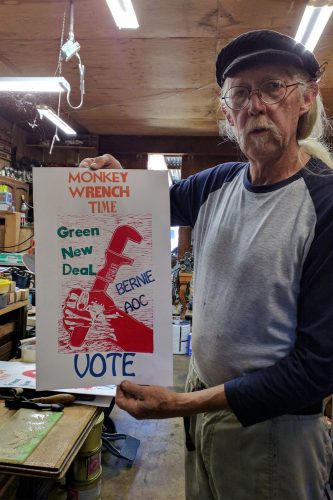
It’s not many people I can bond with over memories of cutting ruby or amberlith screens, the artifacts of now-dead printing processes.
“I loved cutting that,” Sean O’Reilly says.
“Me too,” I say.
We’ve just met, but our experience working in production at publications before the arrival of the digital age unites us as part of an ever-dwindling subculture.
The presses in O’Reilly’s studio, however, go back much further than either of our lives. His printmaking outfit in Dexter, where he lives, contains machinery from the 19th century.
The collection is the kind you might see in a museum or antique shop, used for display or decoration. That’s what he’s afraid of: that his presses and letterpress equipment will wind up not being used after he’s gone.
That concern initiated the idea for Eugene Printmakers, a nonprofit whose mission is to become a “working museum,” particularly catering to schools in the area, connecting young people to the history of the printing press and its role in the democratic process.
The goal is to acquire a mobile unit that can be driven around to various schools, with which students can engage.
O’Reilly’s studio is filled with drawers of letters and specialized machines for printing cards, for example, or matchbox covers, on foil or zinc, operated by treadle, stylus, hat tip mechanism — or, in one case, by copying manually.
Much of the equipment dates back to the 1800s but is not on display. These are the presses O’Reilly works with and has used since he was a high school student printing The Bay Guardian, San Francisco’s underground paper.
“I’m fascinated with printmaking before electricity,” he says.
O’Reilly is 68 years old but speaks about printmaking with the enthusiasm of someone just starting out. He shows me a book from 1892 of antique, ornate type no longer available and points to a page. “I love this stuff,” he says.
When he still lived in San Francisco he met a few graduate students from the University of Oregon. They suggested he come to Eugene to work a press. He came in 1969 with Students for a Democratic Society and printed leaflets for antiwar demonstrations, the Black Panthers and Rainbow Gatherings. He worked as a typesetter and layout artist for Eugene Auger, Eugene’s underground paper.
O’Reilly didn’t get paid for this kind of work, he says. No one did. But in those days the free press was the only way to get the message out.
In 1975 O’Reilly was arrested for draft evasion. It was, he says, part of a “last big hurrah,” even though people weren’t really being drafted anymore. He had to take a physical to qualify for the military — “that wasn’t that hard to fail,” he says.
In 1978 he got a job working for Instaprint, a commercial print shop in town, and has stayed in the area ever since.
My favorite press of his is the Francis Bacon Pantograph Engraver. O’Reilly says it was made in France in 1880 and brought to Oregon shortly after by Elijah Bristow, founder of neighboring Pleasant Hill. It works with a stylus, so it’s like writing or drawing, and it reminded me of a similar “double-writing” machine I saw at Montecello in Virginia.
I asked if O’Reilly saw the one at Thomas Jefferson’s home.
He hadn’t. He’s only been back east once, to go to Woodstock. And he didn’t quite make it; he was arrested and jailed for hitchhiking “within spitting distance” of the now-famous festival.
What O’Reilly likes about prints, as opposed to the internet, is you can hold them in your hand, take your time reading and thinking. The text isn’t here one second and deleted or changed the next.
Facebook is great for connecting people, he says, except it’s a corporation, and you have to be careful.
Having a free press has always interested him. Being able to own your press as a private citizen, he believes, has helped “move democracy forward.”
The day I visited his studio he wasn’t involved in anything political, unless you count printing calendars on coasters as political. O’Reilly printed a month on each coaster in different colors to give as Christmas presents.
He was having eye surgery the following Tuesday. It won’t take long, he says. Meanwhile someone has contacted him about a barn in Washington that’s got some antique printmaking equipment in it.
If he can, he’s going up there the day before his surgery to check it out.